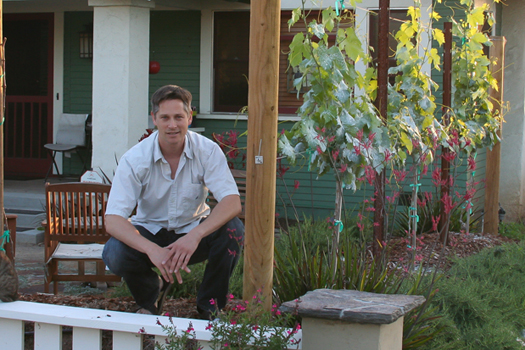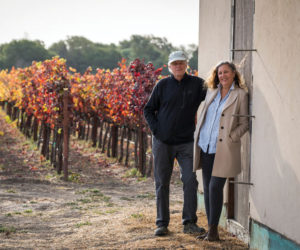
Chris Henry in his San Diego “Urban Microvineyard.”
The yard looks great. What are those?” inquires a woman from the sidewalk, looking in the direction of my four vibrant green grapevines.
“Those are my urban micro vineyard,” I reply from the porch. This inevitably leads to questions of “why” and about making wine.
There is something about vineyards that is soothing to my soul and I had decided long ago that one day, perhaps when I retire, I would own a small vineyard. Not for money or profit, rather for experience and to delve into a world with such a connection to the earth or “terroir” to borrow from the French.
As the years and many glasses passed by, the dreamer in me suddenly burst out and asked, “What are you waiting for? Why not build a vineyard now?”
Rationality replied, “I need to save up money for a large plot of land.” To drive the point home, rationality pressed, “Besides, I live five minutes from downtown San Diego. My house is only a tenth of an acre, not enough for a vineyard. How much wine could you really make in that space? Further, the soil is 90% clay and the other 10% river rock. Finally, I know nothing about growing grapes. In truth everything I have planted has died — not a good indicator of success.” Logic, wanting everyone to get along, stepped in to say, “Let’s learn about vineyards and growing grapes then we can decide later.”
After much research, I purchased books on viticulture and winemaking. I spent nights scouring the Internet for specific bits of information on subjects like soil and grapes, supplies, vine spacing, climate, pruning and harvesting . . . all the while the dreamer desperately searched for others on the Internet with urban-based vineyards — but to no avail. Most grape growers lived in much more rural areas with larger-scale endeavors. Rationality was feeling vindicated. However a strange thing started to happen . . . as knowledge increased, logic compiled evidence that the dreamer may be on to something viable and the scales tipped.
I learned grapevines need 6 to 8 feet between them. A quick measure of my yards revealed that I could get rows of three vines in the front and four in the back. With each vine capable of producing potentially five bottles of wine it wouldn’t take many to produce the ten a year I hoped to produce. But surely the vines cannot grow well in 90–95% clay? A backhoe to dig out a trench and amend the soil appropriately would fix that. Hmm . . . for the first time this actually seemed possible. I could technically grow wine grapes right here in our tiny urban plot of land. Further, grapevines are deep rooting, and as such, drought tolerant. Even rationality seemed convinced, Perhaps a few vines would be worthwhile, I will learn how to grow the vines and make the wine, so I will be ready later on if I want to take it to a bigger scale. Besides with a newborn son, it will be a great experience to share with him over the years. The final challenge now is to package it in a way my wife will accept.
With bad soil, a tiny plot of land, very limited knowledge and no practical experience, I had only the sun going for me yet, despite all these challenges, my vines have surpassed my expectations in their first year, all growing well beyond the top wire. Three Zinfandel vines are off and running, already touching the top wire in late April.





